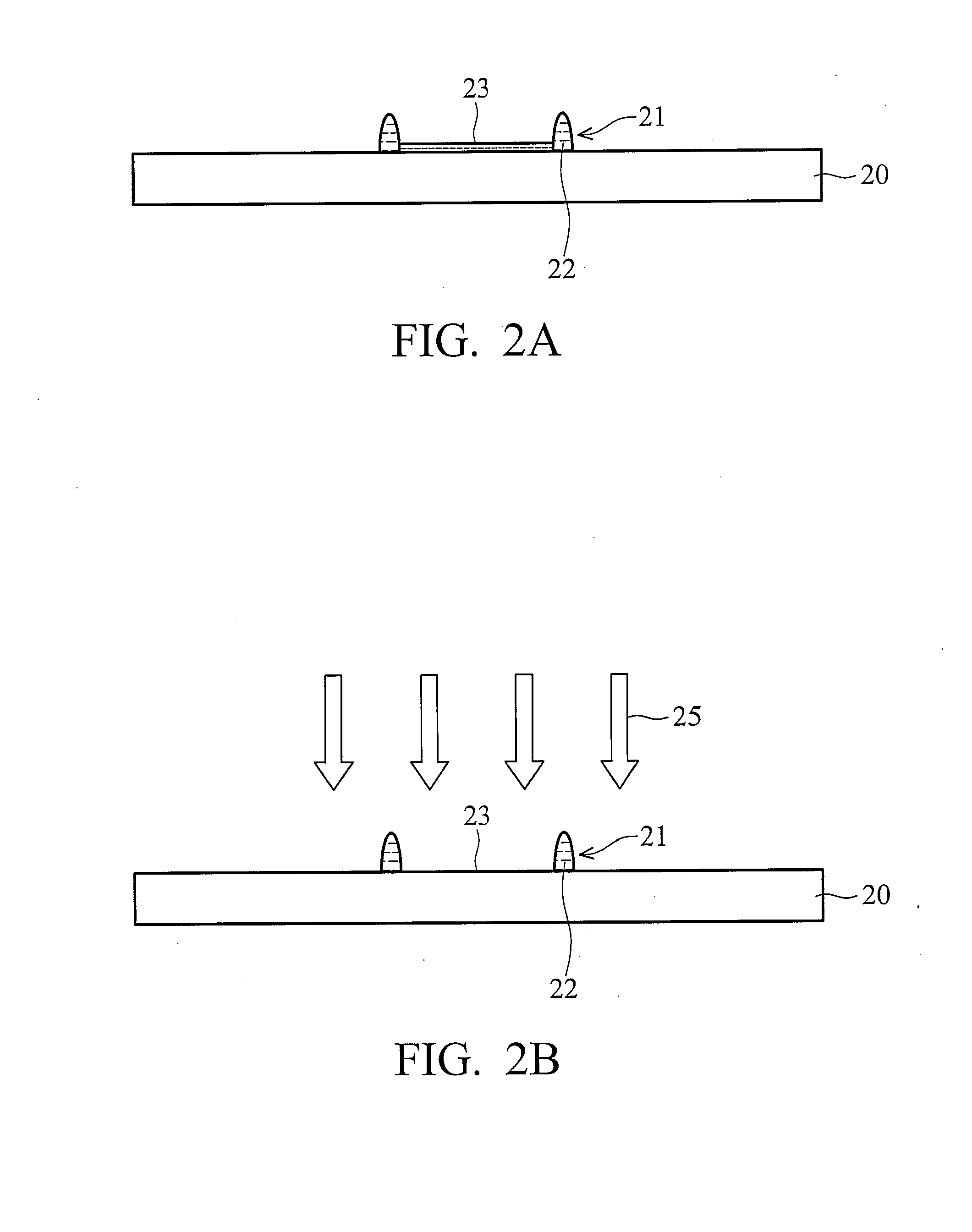Thin-film transistor and fabrication method thereof
a technology of thin film transistor and fabrication method, which is applied in the direction of thermoelectric device junction materials, semiconductor devices, electrical apparatus, etc., can solve the problems of inability to extend the length of the gate (i.e. tft channel resolution) to several micrometers and less, and achieve the effect of widening the application range and simplifying the process
- Summary
- Abstract
- Description
- Claims
- Application Information
AI Technical Summary
Benefits of technology
Problems solved by technology
Method used
Image
Examples
first embodiment
[0035]FIGS. 2A-2F show cross sections of fabrication steps of a first embodiment of the invention. Referring to FIG. 2A, a substrate 20, such as glass, silicon, plastic substrate or other flexible substrate, is first provided. The selected substrate is then cleaned and treated by a surface treatment step such as plasma treatment. A polymer solution is inkjet printed by a sprinkle-nozzle on the substrate 20 into a dot or a line shape, and then dried into a coffee ring film 21. The polymer may be, but is not limited to, poly(3-alkylthiophene) (P3AT), poly(9,9-dioctylfluorene-co-bithiophene) (F8T2), polymethyl methacrylate (PMMA), poly(4-vinylphenol) (PVP), polyvinyl alcohol (PVA), polyacrylonitrile (PAN), polyimide (PI), or polyoxymethylene (POM). The polymer is dissolved in a solvent into a solution for inkjet printing. The solvent includes a watery liquid or an oily liquid.
[0036]Referring to FIG. 2B, a central part 23 of the coffee ring film 21 is removed by an etching method, and t...
second embodiment
[0044]In the second embodiment of the invention, the different semiconductor materials are inkjet printed on the two ridges, one is N type semiconductor, and the other is P type semiconductor, thus completing a CMOS TFT structure.
[0045]As shown in FIG. 5, a substrate 20 is first provided, and then two ridges 22 of the coffee ring are formed on the substrate 20 as a separating layer. A source layer 24 and a drain layer 26 are disposed on opposite sides of the ridge 22. A P type semiconductor layer 27 is disposed on one ridge 22 and portions of the source / drain layer. An N type semiconductor layer 29 is disposed on the other ridge 22 and portions of the source / drain layer. A gate dielectric layer 30 is disposed on the P type semiconductor layer 27, the N type semiconductor layer 29, the source layer 24 and the drain layer 26. A gate layer 32 is disposed on the gate dielectric layer 30, corresponding to the ridges 22. In the second embodiment, with the exception of the P type semicondu...
third embodiment
[0046]According to the structure of the first embodiment, wherein the substrate can be replaced by a substrate having a conductive layer and an inorganic gate dielectric layer, and the upper gate layer and the upper gate dielectric layer can be removed to form a bottom gate device.
[0047]The third embodiment of the invention is as shown in FIG. 6. A substrate 40 is first provided. A bottom gate layer 42 is disposed on the substrate 40, and the patterning process thereof is not required. The material of the bottom gate layer 42 may be a heavily doped N type or P type semiconductor such as a heavily doped Si, Ge, or GaAs; an organic conductive film such as PEDOT; or a metal or an inorganic conductive film such as ITO, IZO, Ag, Au, Al, or Cr. A bottom gate dielectric layer 44 is disposed above the bottom gate layer 42, and underlying a separating layer 46 and a source / drain layer 48 / 50. The material of the bottom gate dielectric layer 44 may be an inorganic insulating material, an organ...
PUM
 Login to View More
Login to View More Abstract
Description
Claims
Application Information
 Login to View More
Login to View More - R&D
- Intellectual Property
- Life Sciences
- Materials
- Tech Scout
- Unparalleled Data Quality
- Higher Quality Content
- 60% Fewer Hallucinations
Browse by: Latest US Patents, China's latest patents, Technical Efficacy Thesaurus, Application Domain, Technology Topic, Popular Technical Reports.
© 2025 PatSnap. All rights reserved.Legal|Privacy policy|Modern Slavery Act Transparency Statement|Sitemap|About US| Contact US: help@patsnap.com



